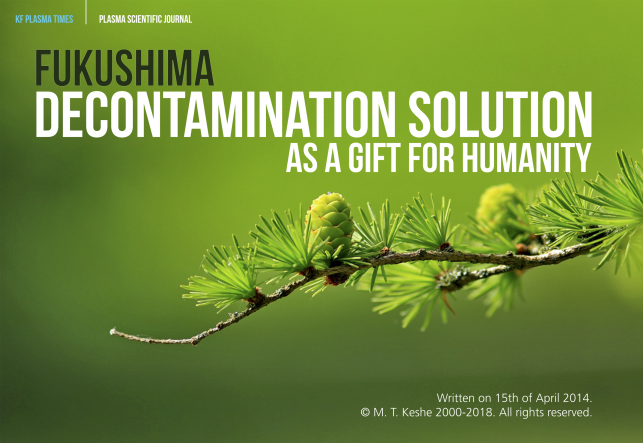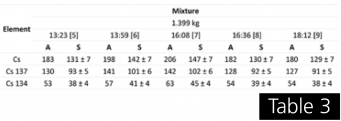Fukushima Decontamination Solution as a Gift for Humanity
This article is part of the KF Plasma Times September 2018
Keywords: radiation, nuclear, environmental contamination, Japan.
Published: September 2018.
Introduction
The origin of this paper is based on the first video, which were released by the Keshe Foundation about how simply the radiation and the radioactive contamination in the farms and the environment around the disaster zone of the Fukushima area was shown to be decontaminated, by the use of new materials developed by the M. T. Keshe.
This, after the tsunami of the 2011, after three years can be resolved, simply by the use of basic materials, farmers on their own and by the community can clean up the environment, rather than with the help of the governmental organizations.
The video is available at: https://www.youtube.com/watch?v=4f02CcnHjSk
Experiments
One of our Knowledge seekers performed a series of experiments with decontamination of radioactive materials using procedures developed by Keshe Foundation and materials prepared by us in its Spaceship Institute in Italy. We were connected with and helping her during this experiments over Skype calls. Gamma ray detectors were used. These shortcuts are used for physical quantities:
• A [Bq] … radioactivity, counts of decayed particles per second
• S [Bq / kg] … specific radioactivity, radioactivity per unit weight
Measured values in ( ) brackets are under measurable threshold of the detectors.
Numbers in [ ] brackets refer to attached measurements.
Experiment in food assurance company in Fukushima RegionSample 1, March 29, 2014
Contaminated radioactive soil from a rice field.
The soil in a box was soaked with well water (Table 1) and few drops of detergent (to allow better release of radioactive elements into the water) and stirred well (Figure 1).
The water from the top of the box was poured into a test container so that most of the soil sediments were kept in the box.
Half of the water from the test container was poured into another test container to remove more soil sediments to get initial water (Table 1).
Part of initial water was treated with cylinder filter with nano layered Copper wires (Table 2) while well water was added to make the filtering simpler (Figure 2-4).
The rest of initial water was treated with Copper compounds material in GANS state. (Table 2, Figure 5). Both previous treated water samples were put together to final mixture (Table 3, Chart 1, Figure 6). Last measured decrease in radioactivity of Cs was 33% relative to initial value. Video recording of this experiment is available at: https://www.youtube.com/watch?v=7hCk4HIjzWk&index=5&list=PL2tl5CAdIAVhqirHaZWVlk_v-bBE0oFFb
Sample 2, March 31 – April 3, 2014
Contaminated radioactive water extracted from a rice field soil with the help of iron […]
Experiment in NPO in Fukushima city
Sample 1, March 30, 2014
Contaminated radioactive soil from a roof gutter […]
Sample 2
Contaminated radioactive water […]
Experiments Summary
Over the measured period of time, all methods showed decreased values of radioactivity in the samples. This decrease was caused by direct transformations of the radioactive material and not by separating the radioactive material by any method of absorption out of the samples (except the cases with nanolayer filters of course). These experimental verifications of the decontamination technology have to be further developed in cooperation with people willing to take part in the global clean up. We are here to help in this process and learn more together to achieve simple real-world application of the disclosed decontamination process.
Knowledge gained
[…] The conclusion from the development of new materials and their use in the contaminated environment of Fukushima and any other reactive environment, like a nuclear waste disposal and storage is as follows:
1. All radioactive contaminated environments and materials can be made fully and permanently radiation safe.
2. The new process of decontamination can bring about new opportunities to convert the radioactive materials to useful and applicable materials, which can be used for scientific development, agricultural use, and energy production for conversion of matters.
3. These tests have shown without a shadow of a doubt that the Japanese Fukushima disaster of 2011 can be used to the advantage of the nation and not as it looks, as a disadvantage and a financial burden.
4. All underground storage facilities and nuclear waste problems of today can be solved with little effort and little cost by the use of these new materials, and there is no need for these heavy radioactive materials to be kept in storage for hundreds of years for them to be less radioactive, now one can safely use the by-products of decontamination for the production and their use in agriculture and material production rather than wasting money to store them for years on end.
5. The test shows clearly that The Fukushima plants we use for the production of plutonium. As a nuclear engineer and being involved in the promotion of peace, I see this as unacceptable and against the present agreed international laws of the proliferation of the UN charter. These tests have shown a new and brighter life for humanity and hopefully, as a race, we become stronger with the gained knowledge. […]








